Classic Yeti Images
Posted by: Loren Coleman on January 13th, 2008
With the death of Sir Edmund Hillary and Yeti images of the photographs from that era (1950s and 1960s), insights into the evolution of how the Abominable Snowmen were viewed can be considered through the lenses of time and distance.
The first image shared here (click on Perkins Yeti) is the 1960 lifesize drawing shown by then-Lincoln Park Zoo director Marlin Perkins before the World Book expedition to the Himalayas with Sir Edmund Hillary. (This may be different than the large cutout Perkins showed on “Wild Kingdom” in 1963, or it may be the same one.)
Below is the slightly different drawing Hillary would show at his 1960’s news conference.
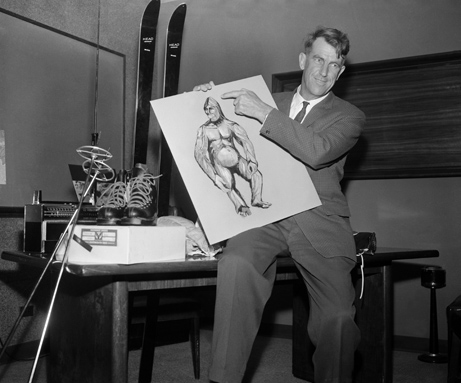
Other images of Yeti were in circulation too, of course. These two drawings of the more apelike, Neandertaloid hairy Yeti are from a 1952 issue of Radar magazine.
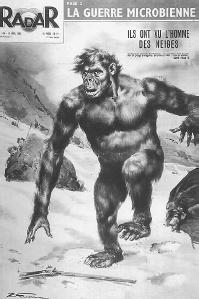
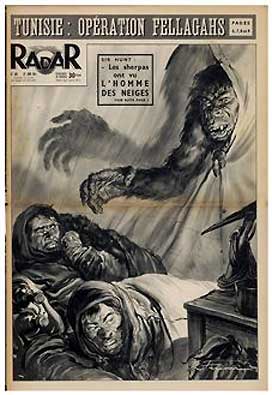
The expedition photographs of the 1950s often would concentrate on the artifacts, such as in this 1954 image of Dr. Biswamoy Biswas examining the Pangboche Yeti scalp during the Daily Mail Snowman Expedition of that year. Sherpas and porters in the background would be reflective of those drawn into the Radar images.

Tintin in Tibet, printed in 1960, had a Yeti that clearly left footprints like the Shipton photograph and had a body influenced by the period’s cryptozoological writings of what the creature looked like.

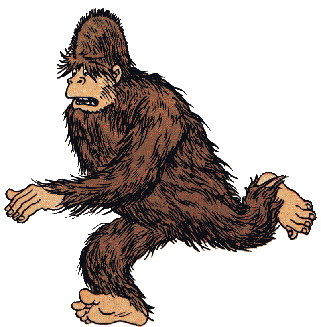
After the debunking Hillary-Perkins expedition of 1960, the Yeti began taking on unrealistic appearances. This Japanese company Marx’s Abominable Snowman (below) was produced in 1963. The model followed the mythical “white” Yeti framing that had come into existence and was seen via this toy which could walk, stop, raise its arms and let out a piercing screech.

Other images of Yeti sometimes were no more than a shadow, as shown here on the cover of Tomek na tropach Yeti by Alfred Szklarski (Wyd.III. Kat. 1968).
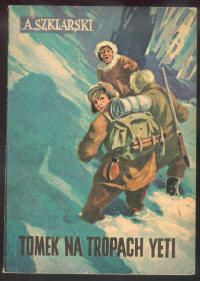
Thanks to Peter Pasavento for the scan of the Soule’s book photo.

About Loren Coleman
Loren Coleman is one of the world’s leading cryptozoologists, some say “the” leading living cryptozoologist. Certainly, he is acknowledged as the current living American researcher and writer who has most popularized cryptozoology in the late 20th and early 21st centuries.
Starting his fieldwork and investigations in 1960, after traveling and trekking extensively in pursuit of cryptozoological mysteries, Coleman began writing to share his experiences in 1969. An honorary member of Ivan T. Sanderson’s Society for the Investigation of the Unexplained in the 1970s, Coleman has been bestowed with similar honorary memberships of the North Idaho College Cryptozoology Club in 1983, and in subsequent years, that of the British Columbia Scientific Cryptozoology Club, CryptoSafari International, and other international organizations. He was also a Life Member and Benefactor of the International Society of Cryptozoology (now-defunct).
Loren Coleman’s daily blog, as a member of the Cryptomundo Team, served as an ongoing avenue of communication for the ever-growing body of cryptozoo news from 2005 through 2013. He returned as an infrequent contributor beginning Halloween week of 2015.
Coleman is the founder in 2003, and current director of the International Cryptozoology Museum in Portland, Maine.










Hey, don’t forget the abominable snowman from bugs bunny. I think he’s my favorite. Considering the animals found in that general area within the past few years, I think it is reasonable to think that with some dedication and persistence that the yeti could be found.
I read Tintin comic books when I was young, and I still have the one listed above somewhere. The entire series is really fun, and this one is no exception. If you can find them I suggest you take a look- they were printed in more than fifty languages, if I remember correctly, definitely worth searching for!
These are realllly fun! I want that Yeti toy!
Hey! where’s the Pixar’s Yeti of Monsters Inc???
“Welcome to the Himalayas! Snowcone?” 🙂
Recent images and representations of Yeti are not “classics,” in terms of looking at the Abominable Snowmen from the 1950s and 1960s, of course.
Here’s another vote for a bigger shot of the Heuvelmans yeti! Hey, I can hope, can’t I?
A question for Loren: Do you think the dome or cone shaped head (if they really have one) of the yeti could be due to the birthing process? This would be much like many human babies that are born with this shape of the skull due to the soft nature of the bone at birth and the birthing process. However, we humans will reshape the skull.